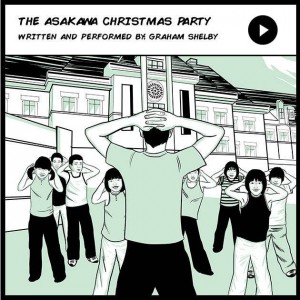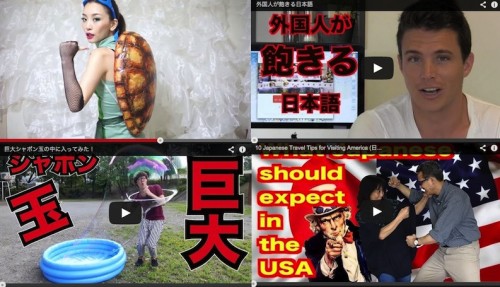JQ Magazine: Manga Review — ‘Showa 1944-1953: A History of Japan’
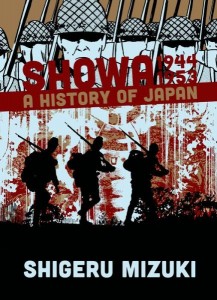
“If you enjoy or are interested in manga and history, or if you appreciate such excellent works as Maus, Persepolis or Barefoot Gen, then this series is a must-read.” (Drawn and Quarterly)
By Julio Perez Jr. (Kyoto-shi, 2011-13) for JQ magazine. A bibliophile, writer, translator, and graduate from Columbia University, Julio is currently working at Ishikawa Prefecture’s New York office while seeking opportunities with publications in New York. Follow his enthusiasm for Japan, literature, and comic books on his blog and Twitter @brittlejules.
Showa 1944-1953: A History of Japan is the third volume in a four-part manga history of the Showa period by eminent manga artist Shigeru Mizuki. (If you’re new to this series, check out JQ’s reviews of the first and second volumes here.)
Since I have already sung the praises of Mizuki’s excellent blending of realistic and comical art and storytelling as well as the top-notch translation by JET alum (and JQ interviewee) Zack Davisson (Nara-ken, 2001-04; Osaka-shi, 2004-06), I have decided to focus this review more on unpacking some of the contents of volume three and providing you with additional resources to look into if you wish to expand your knowledge about any of the topics that appear in the manga, including several wartime tragedies and the postwar occupation of Japan by the Allied Forces.
This volume focuses primarily on the grim latter years of World War II in the Pacific Theater. Despite the fact that Japan’s resources are running far past thin, the government and military persisted in continuing the conflict. This manga puts the spotlight on the plight of soldiers who have become the least important resource to the Japanese government, “Human life is the least valuable resource in the Japanese Army,” Mizuki writes. “Any suggestion that soldiers’ lives have meaning is tantamount to cowardice and treason. Soldiers are tools to be used. And the command’s greatest fear is that soldiers will flee from the enemy—or worse, surrender. They need them more afraid of dishonor than death.”
JQ Magazine: JQ&A with Patrick Newell, Founder of Tokyo International School
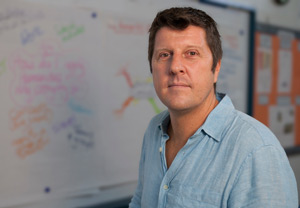
“Technology is constantly changing and students need to be equipped with the skills to master changing technology. They also need to be prepared for environmental, financial, civic and global literacy because of the interconnectedness of these issues in a globalized world.” (Courtesy of 21foundation.com)
By Lyle Sylvander (Yokohama-shi, 2001-02) for JQ magazine. Lyle has completed a master’s program at the School of International and Public Affairs at Columbia University and has been writing for the JET Alumni Association of New York since 2004. He is also the goalkeeper for FC Japan, a New York City-based soccer team.
Patrick Newell founded Tokyo International School in 2001, which has since become a model institution in many areas of education and learning. The same philosophy is behind the recent launch of the Global Institute, a 21st century kindergarten and afterschool program based in Naka-Meguro.
Patrick holds a postgraduate diploma from Oxford Brookes University with a concentration in international education, and has been a speaker and participant in over 20 international school conferences and workshops. He has also chaired International School Accreditation Teams for the Council of International Schools and New England Association of Schools and Colleges, and currently serves as the chair of the American Chamber of Commerce in Japan (ACCJ) Learning Committee.
In this exclusive interview, Newell shares with JQ how traveling the world sparked the interest his chosen profession, the subjects essential for students of the 21st century, and his work through the years as a coordinator and speaker for TEDx in Japan.
How did you become interested in education?
I fell into it while traveling the world. I was working in real estate in Southern California when I suddenly decided that I didn’t want to live that corporate life anymore. So, at the age of 25, I bought a multiple-stop airline ticket to travel the world. I went through the Caribbean, Europe, India and Thailand. While in Thailand, I decided that I wanted to spend a considerable amount of time somewhere in Asia and decided that Japan would be the best place to do it. I moved to Tokyo and joined my wife in the English education business. We then started an English tutoring service for students at international schools. I didn’t have any formal educational training, and so relied on my intuition and what was valuable or wrong from my own education. Education became a passion of mine and I was researching and developing my own model while observing the different models among the international schools in Japan.
Why did you found the Tokyo International School?
We had two daughters and decided to open an international school for them. We started with a preschool and then decided to open Tokyo International School. We started with 12 students in one classroom and now have over 320 students from 50 countries. It was such a challenge opening an international school in the oldest international school market in the world.
JQ Magazine: JQ&A with Laurel Lukaszewski, JETAA Initiative Project Director
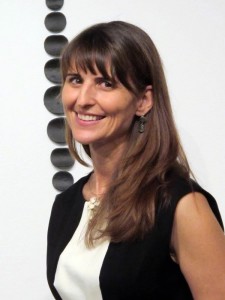
“I believe very strongly that a national organization will strengthen the network and relationships between both chapters and individual alumni, as well as elevate the status and recognition of the JET Programme and its alumni in the greater U.S.-Japan arena.” (Courtesy of Laurel Lukaszewski)
a
By Eden Law (Fukushima-ken, 2010-11) for JQ magazine. Eden currently serves on the JETAA New South Wales committee in Sydney, Australia as the online social media, webmaster and occasional editor. Got feedback? Leave a comment below.
In 2013, the JETAA Initiative project was launched by the United States-Japan Bridging Foundation (USJBF), with funding provided by the The Japan Foundation Center for Global Partnership (CGP). The first phase of the project was to assess the feasibility of a national JETAA organization, with the next phases dealing with the structure, duties and objectives of the new organization.
The first phase (feasibility study) has now wrapped up and its findings presented at the September 2014 National JETAA USA Conference, and the next phase is currently underway. JQ spoke with Laurel Lukaszewski (Kagoshima-ken, 1990-92), JETAA Initiative project director (who is also a highly noted, Washington D.C.-based ceramic artist in her own right), who kindly gave her time to discuss the JETAA Initiative, the findings and next steps for the project.
How did you come to be selected for the role of project director of the JETAA Initiative?
I applied for the position after I saw the job announcement posted in a number of different places. I work as an artist full-time, but my schedule is flexible and I thought this would be an exciting project. In my previous career, I was the executive director of the Japan-America Society of Washington, D.C. Before that, I worked for the Japan-America Society of the State of Washington in Seattle as their program director. I’ve also been part of the JET selection process for over 15 years (reviewing applications, interviewing, working at the embassy as the review committee liaison for two seasons). I have also been a board member of the National Cherry Blossom Festival since 2002 and have served on a number of arts-related nonprofit boards and committees over the years. I was also the secretary, then president, of the JETAA Pacific Northwest chapter in Seattle in the late ’90s, so JETAA is near and dear to my heart.
It’s been a year since your appointment. What were the main challenges you faced as a director?
While not exactly a challenge, it has been paramount to reach out to all 19 chapters in the U.S. to give them an understanding of what we are doing and why we think creating a national organization is necessary. To do this, both [JETAA co-founder] Paige Cottingham-Streater (Mie-ken, 1988-89) and I have attended national and regional conferences to give presentations and speak with alumni to garner their support. We have also made site visits to chapters in Kansas City, Atlanta and Denver to find out what challenges exist at the local level. It was also imperative to show the progress we made over the first year to our funder, The Japan Foundation Center for Global Partnership, so that we could continue.
Why was there a need to examine to conduct a feasibility study on whether a national organization was required?
The only way a national organization will be successful is if the JET alumni community wants it. This is being created for them. I believe very strongly that a national organization will strengthen the network and relationships between both chapters and individual alumni, as well as elevate the status and recognition of the JET Programme and its alumni in the greater U.S.-Japan arena, but the JET alumni community needs to believe this, too. We hope that the national organization will provide much needed support to smaller chapters and give alumni who live outside of large cities a way to connect to the broader JETAA community.
Writer Graham Shelby (Fukushima 1994-97) recently teamed up with The Butcher’s Apron Radio Show to produce this full-on audio story (music, sound EFX, the whole thing) about a distinctly JET experience.
“The Asakawa Christmas Party” tells the true story of a complicated Christmas party Graham and a few other American JETs attended at a Japanese elementary school. It was complicated because…
a.) it took place on the anniversary of the Pearl Harbor attack.
and…
b.) the teachers asked them to teach “a traditional American Christmas dance.” (FYI – there aren’t any).
How’d it turn out? Doozo.
The story was produced as part of Selfridge and Co’s Reasons to Believe series of original Christmas tales. Graham has a few more Japan stories here.
Justin’s Japan: Nippon in New York — Takashi Murakami, Studio Ghibli Documentary, Japan Society Party
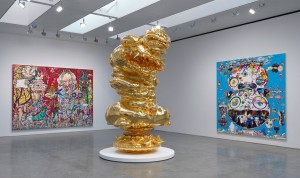
See Takashi Murakami: In the Land of the Dead, Stepping on the Tail of a Rainbow at the Gagosian Gallery through Jan. 17. (Kaikai Kiki Co., Ltd. All Rights Reserved.)
By JQ magazine editor Justin Tedaldi (CIR Kobe-shi, 2001-02) for Examiner.com. Visit his Japanese culture page here for related stories.
With Thanksgiving (and the hopes of sensible eating) now just a memory, we turn to colder weather, falling snow, and the new year to come. Fortunately for Japanese culture fans, December is just as busy as the holiday season itself. Whether you’re hosting guests from out of town or looking to squeeze in an event or two in between parties, we’ve got you covered.
This month’s highlights include:
Now through Jan. 17
Takashi Murakami: In the Land of the Dead, Stepping on the Tail of a Rainbow
Gagosian Gallery, 555 West 24th Street
Free
Since the devastating Great Tōhoku Earthquake of 2011, prolific contemporary visual artist Takashi Murakami has explored Japanese art produced in response to historic natural disasters. Combining classical techniques with the latest technologies, he moves freely within an ever-expanding field of aesthetic issues and cultural inspirations. Mining religious and secular subjects favored by the so-called Japanese “eccentrics” or non-conformist artists of the Early Modern era commonly considered to be counterparts of the Western Romantic tradition, Murakami situates himself within their legacy of bold and lively individualism in a manner that is entirely his own and of his time.
Friday, Nov. 28
The Kingdom of Dreams and Madness
IFC Center, 323 Sixth Avenue
$14
New York premiere! Granted near-unfettered access to the notoriously insular Studio Ghibli, director Mami Sunada follows the three men who are the lifeblood of Ghibli—the eminent director Hayao Miyazaki, the producer Toshio Suzuki, and the elusive and influential “other director” Isao Takahata—over the course of a year as the studio rushes to complete two films, Miyazaki’s The Wind Rises and Takahata’s The Tale of The Princess Kaguya. The result is a rare “fly on the wall” glimpse of the inner workings of one of the world’s most celebrated animation studios, and an insight into the dreams, passion and singular dedication of these remarkable creators.
Wednesday, Dec. 3, 9:00 p.m.
Midnight in the Garden of Unearthy Delights Party
Japan Society, 333 47th Street
$25/$20 Japan Society members (until Dec. 2, $30/$25 afterward)
Japan Society Gallery serves up an exclusive after-dark soirée for patrons to escape into the wildly imaginative virtual gardens of its hit exhibition, Garden of Unearthly Delights: Works by Ikeda, Tenmyouya & teamLab. Sip some wine, beer, or a signature sake cocktail concocted just for Japan Society by JET alum Chris Johnson (Oita-ken, 1992-95), one of the country’s foremost experts on sake; enjoy the swinging sounds of jazz quartet The Red Birds + Francesco Ciniglio followed by the beats of DJ Aki til midnight; dig deep into the Garden with specially themed expert guided tours available all night; satisfy your sweet tooth at our dessert bar featuring tasty treats, fruits, and cheeses; and more! All food and drinks are covered by the cost of admission. Participants must be 21 years old or over.
For the complete story, click here.
JQ Magazine: Film Review — ‘The Kingdom of Dreams and Madness’
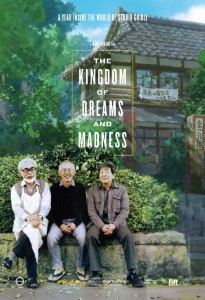
“Although beautiful and carefully crafted, in the end this work is one that ushers you into a new era of Ghibli by giving you a bittersweet goodbye.” (GKIDS/TIFF/© 2013 dwango)
By Alexis Agliano Sanborn (Shimane-ken, 2009-11) for JQ magazine. Alexis is a graduate student of Harvard University’s Regional Studies—East Asia (RSEA) program, and currently works as an executive associate at Asia Society in New York City.
The Kingdom of Dreams and Madness is a documentary following animation director Hayao Miyazaki during his last months at Studio Ghibli. Centering on the production arc to The Wind Rises, Miyazaki’s final and most controversial film, it offers a unique glimpse into the fading days of Studio Ghibli with Miyazaki at the helm.
The film is directed by Mami Sunada, a former assistant director on Hirokazu Kore-eda’s films. Although the documentary does not detail the advent of the unprecedented behind-the-scenes access, from its beginning Sunada and Miyazaki share a tacit understanding that his film straddles a nebulous period. It is the beginning to the end of an era. As Miyazaki admits unreservedly, “I’m a man of the 20th century. I don’t want to live in the 21st.” This documentary captures his twilight world.
Fading though Studio Ghibli may be, it is still a place where one anticipates a world not beholden to reality. What one finds is an atmosphere entrenched in the daily slog. There are deadlines to be met, decisions to be made, marketing, budgeting, and finances that throw the project for a whirl. It is a work place like any other. Somewhat unromantic.
Yet, just like the Ghibli films themselves, this documentary captures the beauty of the everyday. It is there we find appreciation, meaning and relevance through details and rituals. For Miyazaki, these include greeting kindergarteners on their way to school, going up to the rooftop to “watch the sky,” or even the small cheerful doodles pinned about the office with inspirational messages. These simple elements stitch the work into something meaningful.
JQ Magazine: Book Review — ‘Kuma-Kuma Chan, the Little Bear’
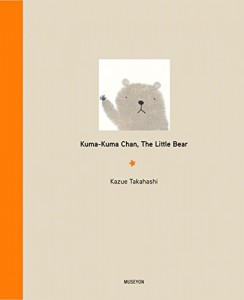
“The simplicity of the storyline and illustrations makes it easy for young readers, and also invites parents and children to dive deeper and create their own dialogue and inquisitions.” (Museyon Inc.)
By Heather Wilson Tomoyasu (Ibaraki-ken, 2004-06) for JQ magazine. Heather is a blogger on her site US-Japan Fam, owner of Miny Moe (multi-brand variety packs that allow parents to find the best brand for their baby), founder of Tunes 4 Bay Ridge Tots, and mommy to her yummy toddler, Kenzo! You can follow and connect with her on Twitter, Facebook, Pinterest, and Instagram.
I’m a sucker for the word chan. Seriously. I don’t know what it is; chan is just so endearing and cute and, well, Japanese!! If you’re a chan-aholic like me, get excited, because there is a new children’s book coming your way that is all about the chan!
The beloved children’s book, Kuma-Kuma Chan, the Little Bear, originally written by Kazue Takahashi and published in Japan in 2001, has just been translated into English, republished by Museyon, and will be available in stores and online Dec. 1 (just in time for those stocking stuffer purchases—hoorah!!). This hardcover book is small, about 5” x 7”, with 52 pages of simple-yet-adorable illustrations and minimal text. The story is short and sweet, with Takahashi describing what she imagines Kuma-Kuma Chan to do every day. With each turn of the page, you are greeted with an illustration and a single sentence describing a different chore or activity, such as shopping, gardening (and sometimes hurting his back), and personal hygiene such as, “He trims the nails of his paws. Then he lines up the cut nails and gazes at them.” I mean, come on, that is kind of hilarious.
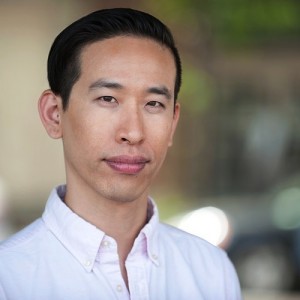
“Living in Japan, you learn not just the Japanese language, but a new kinesthetic language as well, such as bowing all the time like it’s an instinct, or getting used to sitting on a tatami mat instead of a chair, or bathing Japanese-style. It’s like a new vocabulary for living in your own body.” (Martin Bentsen/City Headshots)
By Rafael Villadiego (Nagasaki-ken, 2010-13) for JQ magazine. A member of JETAA New South Wales, Rafael is a collector of words on a journey still searching for a destination, who has a tendency to forget, we are all sometimes like the rain…
Lee-Sean Huang (Oita-ken, 2003-06) was an ALT in Nakatsu City. Upon returning to the United States, he became the webmaster for JETAA New York. In 2008, together with Steven Horowitz (Aichi-ken, 1992-94), he helped to found JETwit.com in 2008 as an avenue for connecting and giving voice to the JET alumni freelance and professional community.
A modern-day Renaissance man, Huang is the co-founder and creative director behind the community-centered design and social innovation firm Foossa. He is also a faculty member at SVA’s MFA Design for Social Innovation program and an instructor of the Brazilian martial art capoeira.
He recently joined the Wisdom Hackers collective together with other likeminded artists, activists and entrepreneurs, to which he contributed a chapter entitled “The Thinking Body,” which outlines his views behind the virtues of kinesthetic creativity. In this exclusive interview, Huang shares his journey and thought processes with JQ’s readers.
The philosophical dispatches from Wisdom Hackers are described as an “incubator for philosophers that compiles dispatches from young, edgy thinkers from major cities across the globe.” Can you tell us a little more about this initiative and how you got involved?
We are building a movement for critical inquiry and connecting ancient wisdom to our contemporary context. In our present form, we are partnered with e-publishers The Pigeonhole and releasing a dispatch a week over 10 weeks. Next year, we plan on releasing a limited edition physical book made by monks in Denmark. Beyond publishing our own ideas, we want to create a curriculum or “cookbook” of sorts, and get it into schools, colleges, and other learning environments. The Wisdom Hackers curriculum would provide a starting point for anybody to start asking deep questions, think critically, and create their own dispatch to tell their own story and perspective. The curriculum would also include a guide for how to build your own community of like-minded seekers. That’s a bit of a preview of where we are going with Wisdom Hackers.
My friend Alexa Clay is one of the original instigators of Wisdom Hackers. We were introduced a few years ago through a mutual friend, Alnoor Ladha, who is also a Wisdom Hackers seeker. I ended up becoming an advisor for Alexa’s book, The Misfit Economy, and on her project, League of Intrapreneurs. When Alexa approached me about Wisdom Hackers, I jumped at the idea. I had a bunch of ideas floating around in my head that did not fit in the format of the usual blog posts and articles that I write as part of my design and teaching career. I also liked the challenge of writing longer form content, something I was a little afraid of doing, but that is exactly why I said “yes.”
You are certainly amongst august company. Have you had any direct interaction with the other “seekers” of your collective, or have you developed your ideas primarily on your own?
I have become good friends with the New York-based Wisdom Hackers crew. We hosted a Wisdom Hackers panel discussion here in September. We have edited each other’s dispatches and also have a private Facebook group where we share ideas, so there is lots of cross-pollination happening.
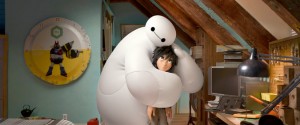
“Visually, the film is a treat, as the animators have combined elements of Japanese anime with Hollywood CGI-style animation.” (Walt Disney Pictures)
By Lyle Sylvander (Yokohama-shi, 2001-02) for JQ magazine. Lyle has completed a master’s program at the School of International and Public Affairs at Columbia University and has been writing for the JET Alumni Association of New York since 2004. He is also the goalkeeper for FC Japan, a New York City-based soccer team.
When the Walt Disney Company acquired Marvel Entertainment in 2009, it became inevitable that the superheroes in the comic book canon would find themselves headlining their own Disney movies. That notion came to fruition in 2012 when Disney released Marvel’s The Avengers, followed by the Thor, Iron Man and Captain America sequels. The lesser-known comic book superheroes collectively known as the Guardians of the Galaxy made their debut in 2014 and grossed an astounding $765 million worldwide.
Coming on the heels of that release is the latest Disney-Marvel collaboration, Big Hero 6—the first to be produced by its animation division. Unlike the other films, Big Hero 6 is aimed at the family audience so that it can entertain young children as well as teenagers and adults. It shares more in common with another Disney subsidiary named Pixar than its Marvel brethren. While it does not attain the high standards set by Pixar in such films as Toy Story, Monsters Inc. and The Incredibles (let’s face it—nothing does), it is an entertaining and fun movie.
Presumably the characters in Big Hero 6 are not well known outside the realm of comic book fandom—they don’t have the name recognition of Spider-Man, the Hulk, the Fantastic Four, etc. But the absence of brand recognition comes with a pair of trump cards: low preconceived expectations and the element of surprise. Many in the audience will be introduced to the characters and world of Big Hero 6 for the first time—and it is a remarkably innovative world.
Justin’s Japan: Nippon in New York — ‘Big Hero 6,’ Babymetal, Richie Kotzen, Asa Akira, Perfume
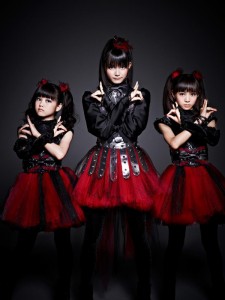
Babymetal brings their unique brand of “kawaii metal” to Hammerstein Ballroom Nov. 4. (Courtesy of WME Entertainment)
By JQ magazine editor Justin Tedaldi (CIR Kobe-shi, 2001-02) for Examiner.com. Visit his Japanese culture page here for related stories.
From Disney to heavy metal to J-pop, November is just as colorful as the leaves tumbling through the air. Add to that a cutting-edge kimono exhibition, a Shakespearean samurai epic, and the largest event in the USA dedicated to love and sex, and you’ve got an irresistibly epic rundown.
This month’s highlights include:
Tuesday, Nov. 4, 7:00 p.m.
Hammerstein Ballroom, 311 West 34th Street
$49.50
Formed in 2010, Babymetal brings a kawaii blend of traditional schoolgirl J-pop and death metal. Hot off the heels of their debut album released in the U.S. earlier this year, the band has been burning up the charts in Japan, where their live video for “Gimmie Choco!!” (lensed at the legendary Nipon Budokan in Tokyo) has racked up over 17 million views on YouTube to date. Endorsed by shredders like Marty Friedman (Megadeth) and Jeff Walker (Carcass) alike, Babymetal are prepared for a whole new audience on the eve of their Hammerstein debut.
Wednesday, Nov. 5, 7:30 p.m.
B.B. King Blues Club and Grill, 237 West 42nd Street
$28-$32
With guitar styles ranging from rock, blues, jazz and fusion to pop and soul, Richie Kotzen has built a remarkably diverse 25-year career as a guitarist, singer and songwriter. A veteran of numerous groups including the Winery Dogs, Kotzen’s Japan cred is extensive: He wrote the number one song “Shine” as a member of Mr. Big, which was used as the ending theme for the anime series Hellsing, has recorded an entirealbum of music from the anime series Gundam, and toured as the opening act on the Japanese leg of the Rolling Stones’ 2006 tour. The Kotzen Telecaster guitar has repeatedly been the #1 selling signature model guitar for Fender Japan. This special solo show will include selections from The Essential Richie Kotzen, the artist’s latest release, which caps a career of highlights in anticipation for his next studio album coming next year.
Nov. 6-12
Nippon Club Gallery, 145 West 57th Street
Free
Kiyomi Kitagawa, a popular fashion designer and a representative of Atelier Bi-no-Sei, revives stylish and practical design dresses in harmony with modern lifestyle from traditional craftwork, a microcosm of Japanese sensibility that has been shaped by the passing of the “four seasons” since ancient times. These dresses show not only the “craftsman’s spirit” by seasoned artisans, but also her knowledge and experience as a textile garment designer. At this exhibition, 30 pieces of kimono dresses—some using fabric no longer produced—will be displayed with luxurious embroidery and a variety of techniques.
For the complete story, click here.
JQ Magazine: Book Review — ‘Starting Point: 1979-1996’ by Hayao Miyazaki
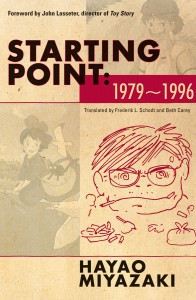
“For those who enjoy the process and precision behind an art, Starting Point is a rare glimpse into an often-times enigmatic industry.” (VIZ Media LLC)
By Alexis Agliano Sanborn (Shimane-ken, 2009-11) for JQ magazine. Alexis is a graduate student of Harvard University’s Regional Studies—East Asia (RSEA) program, and currently works as an executive assistant at Asia Society in New York City.
Starting Point: 1979-1996, translated by Beth Cary and Frederik L. Schodt, is quite unlike its sequel, Turning Point: 1997-2008 (read JQ’s review here). Technical rather than creative, Starting Point shares renowned director Hayao Miyazaki’s recollections of his early days as an animator. The essays and interviews follow anime through production development, touching on the intricacies of character design, layout, and story adaptation. For those who enjoy the process and precision behind an art, Starting Point is a rare glimpse into an often-times enigmatic industry.
The first half of the work features essays on Miyazaki’s long hours in the studio, culture, and nature of Japan’s animation industry in the 1960s and 1970s. As Miyazaki notes, even then, anime was tied to media mix marketing. You didn’t just have manga; you had manga, then an anime, toys, merchandise, and spin-offs all fueling off each other. Says Miyazaki in a 1982 interview: “The world of anime makes its business out of themes like departing for new horizons or love, while pretending not to be conscious of [the] commercial reality.” In hindsight, these remarks prove ironic; the auteur’s Studio Ghibli having similarly succumbed to commercialization.
It isn’t just media mix that remains the same today: professional frustrations were high and work-life balance poor. Miyazaki, over the course of several essays, recounts the life of a young professional. He states: “When young, nearly all of us want to be taken seriously, as soon as possible….In fact, many of those who have not yet taken the plunge into the professional world…tend to speak endlessly about techniques, or concentrate on gaining as much knowledge as possible….In reality, however, once you enter this industry, the techniques required can be mastered very quickly.”
【RocketNews24】Why Japanese doesn’t need swear words
Posted by Michelle Lynn Dinh (Shimane-ken, Chibu-mura, 2010–13), editor and writer for RocketNews24. The following article was written by Casey Baseel, a writer and translator for RocketNews24, a Japan-based site dedicated to bringing fun and quirky news from Asia to English speaking audiences.
The other day, my wife and I spent the day hanging out at the beautiful and awesome Hitachi Seaside Park. As we headed towards the exit at dusk, I pointed to a grove of trees with the sun setting behind them and got to bust out one of my favorite five-dollar Japanese vocabulary words: komorebi.
In retrospect, two things come to mind. First, shouldn’t a five-dollar Japanese word really be a 500-yen word? And second, why is it that the Japanese language has vocabulary as specific as komorebi, meaning “sunlight filtering though trees,” yet doesn’t have a good equivalent for *#&!, %?$!, or even &*!$?
Heads up! The following discussion of profanity contains language that might best be read when you’re not at work or school.
Read more at RocketNews24!
JQ Magazine: JQ&A with Web Entrepreneur Vanessa Villalobos

“If you create businesses based on your own experience and enthusiasms, you’ll never tire of them. Be sure to network with JETAA to stay in touch with people who are interested in Japan.” (Courtesy of Vanessa Villalobos)
By Rafael Villadiego (Nagasaki-ken, 2010-13) for JQ magazine. A member of JETAA New South Wales, Rafael is a collector of words on a journey still searching for a destination, who has a tendency to forget, we are all sometimes like the rain…
Like many JET alums, Vanessa Villalobos (Tochigi-ken, 2000-03) thoroughly enjoyed her time in Japan and was seeking a practical means to maintain that connection upon returning home. Seeking to recapture her experiences on the JET Program and maintain her Japanese language skills after returning to the United Kingdom, she founded the travel/lifestyle/culture site JapaneseLondon.com and the language exchange hub, IsshoniLondon.co.uk.
As an independent businesswoman and entrepreneur, she offers some advice to JQ readers seeking to pursue their own ventures and shares some insight into the trials and tribulations of language exchange. She also offers insider tips to discovering the hidden Japan in London along with the colorful contrasts between the two island nations, her thoughts on the recent vote for Scottish independence, and her take on the UK version of nattō.
How long did you spend on the JET Program and in which prefecture were you placed?
I was a “one-shot” ALT in Tochigi-shi for three years. Tochigi-ken is north of Tokyo and is famed for Nikko, strawberries and gyoza.
How did your time on JET influence the overall design and purpose of the websites?
Japan was endlessly fascinating to me, and I loved teaching Japanese learners of English. Thus, I chose to focus my business endeavors on connections between Japan and England.
IsshoniLondon.co.uk connects private tutors of English to Japanese learners of English. Most of the tutors are ex-JETs. In my intro video on the site, I explain how the kindness of friends and teachers in Japan allowed us teachers to develop an understanding and fondness for Japanese language and culture, and how we hope Japanese people will develop the same fondness of the UK. I am always looking for top-quality tutors, so please do get in touch if you’d like to work as a freelance tutor.
JapaneseLondon.com does what it says on the can! It’s a labour of love and is all about discovering Japanese things in London. It promotes and profiles the individuals, events and businesses that together make up “JapaneseLondon”! There is an events calendar, and I’ve just added a job board. Please do sign up to the newsletter on the site! JapaneseLondon.com can also connect you to a tutor of Japanese here in London!
Do you have any advice for JETs looking to setup similar initiatives in their hometowns?
Just get stuck in—and don’t give up. If you create businesses based on your own experience and enthusiasms, you’ll never tire of them. Staying power is important as it is sooo hard to build your own business from scratch. But it is deeply satisfying at the same time! Be sure to network with JETAA to stay in touch with people who are interested in Japan.
【RocketNews24】Learn Japanese from YouTube: Amp up your listening skills with this four-step guide
Posted by Michelle Lynn Dinh (Shimane-ken, Chibu-mura, 2010–13), editor and writer for RocketNews24. The following article was written by Fran Wrigley, writer and translator for RocketNews24, a Japan-based site dedicated to bringing fun and quirky news from Asia to English speaking audiences.
It used to be that if you were studying a foreign language in your own country, the only listening practice that was easily available to you was hearing your teacher or classmates speak, or listening to the CD that came with your textbook. The first Japanese textbook I ever bought actually came with a cassette tape, which was particularly irritating as it was 2006 and I didn’t even own a Walkman any more.
Then someone invented a website that allowed users to upload short videos for all the world to see. Fast-forward nine years and YouTube is one of the biggest sites on the planet, making it a veritable treasure trove of free online spoken content.
So whether you’re after language lessons, YouTubers who vlog in Japanese, or just want to try watching your cat videos in a foreign language, online videos could be your new secret weapon. The trick is just knowing where to look.
Continue to our four-step guide here!
JET alum’s column on Ebola in USAToday
JET alum Emily Metzgar (Shimane-ken, 1995-93), a professor of journalism at Indiana University, has a column in USAToday this week titled, “Is U.S. ‘stuck on stupid’ on Ebola outbreak?”
If Emily’s name sounds familiar, it’s because she’s also the author of Promoting Japan: One JET at a time, a paper based on surveys of and research on the JET alumni community that attempts to measure return on JET-vestment.

